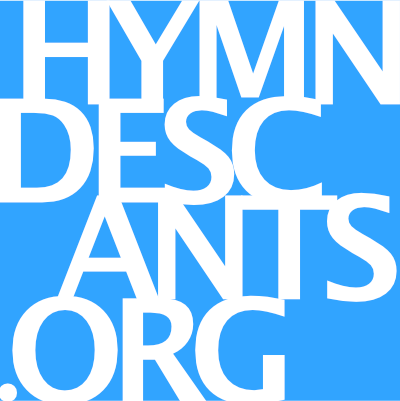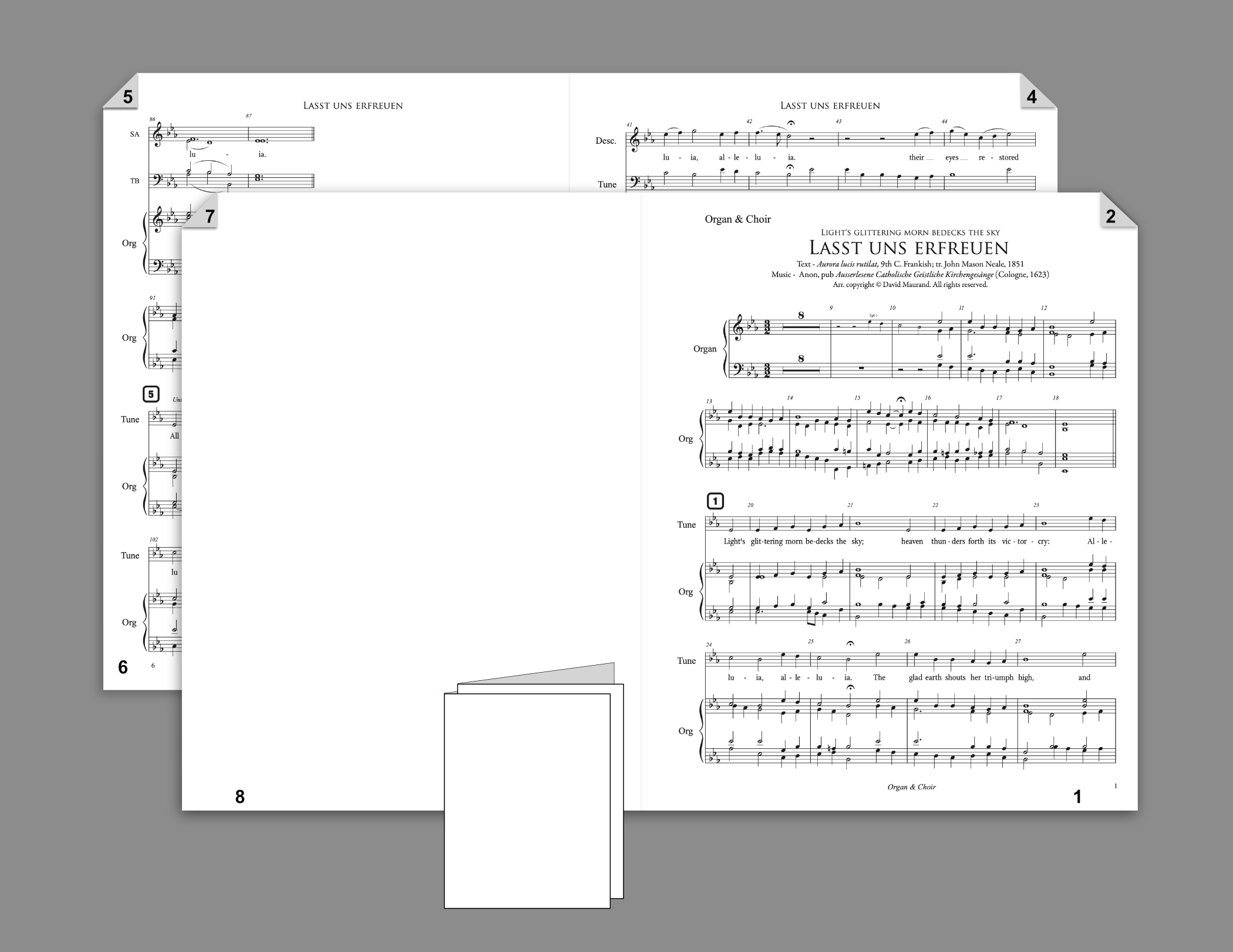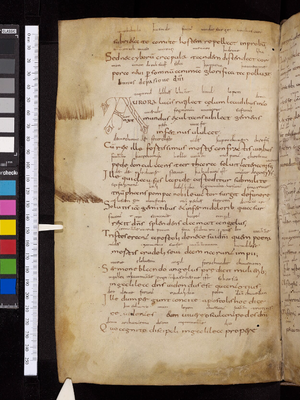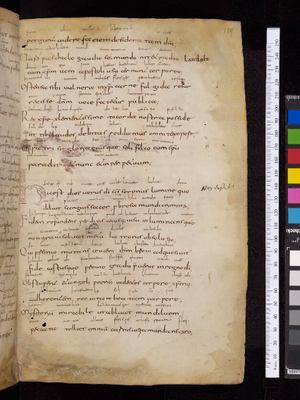
Audioplayer
Lasst uns erfreuen
Light's glittering morn
Brass quintet, timp, organ, choir, and congregation
Five-verse arrangement of the Easter hymn Light's glittering morn, translated by John Mason Neale from the 9th C. office hymn, Aurora lucis rutilat ("Dawn's light glitters") as found in the 2013 edition of Hymns Ancient and Modern. The tune was the setting for the Easter hymn, Lasst uns erfreuen herzlich sehr, an anonymous tune which first appeared in the Jesuit hymnal Ausserlesene Catholische Geistliche Kirchengesänge (Cologne, 1623, ed. Friedrich Spee).
Price:
$35.00
The hymn Light's glittering morn is translated from the 9th C. office hymn, Aurora lucis rutilat ("Dawn's light glitters") found in the Frankish Murbacher Hymnen, a collection of 27 Carolingian-era hymns compiled at the Murbach Abbey, of which only one copy has survived. Because it is written in an Ambrosian meter, it is thought by some scholars to have antecedents though no earlier sources are known. The texts are in Latin with translations in Old High German formatted as interlinear glosses. The original eleven verses plus doxology have since been separated in the Roman Breviary into three separate hymns for use at Lauds, which is sung at daybreak; the current version is from John Mason Neale's translation, as found in the 2013 edition of Hymns Ancient and Modern, which compresses the original versification into a single, five-verse hymn. You can view the Murbach source at the Bodleaian Library website.
The tune was the setting for the Easter hymn, Lasst uns erfreuen herzlich sehr, which celebrates the resurrection narrative from the perspective of Mary. It first appeared in the Jesuit hymnal Ausserlesene Catholische Geistliche Kirchengesänge (Cologne, 1623, ed. Friedrich Spee), and the setting quickly produced variants regarding the distribution of the alleluias. German literature usually attributes authorship of both the text and the tune to the collection's editor. As a poet and hymnologist, the attribution to him of the text is plausible; however there are no first-hand references to support an assertion of musical composition. Moreover, the opening phrase can be found in a tune 100 years earlier attributed to Matthäus Greiter and adapted to GENEVAN 36 and 68, published in 1525. Authoritative English language sources are devoid of the attribution to an author. Originally rendered in common time, Ralph Vaughan Williams' harmonization rendered the music in the now more familiar 6/4 for the 1906 English Hymnal, which was set to Aethelstan Riley's Ye watchers and ye holy ones, based on the ancient hymns Te Deum and Axion Estin. In the spirit of England's pre-WWI zeitgeist, the tune was re-named Vigiles et Sancti, a convention that persisted for several decades in many English language hymnals.
References
Daw, Carl P., Jr. Glory to God: A companion, Westminster John Knox Press, 2016 (Louisville KY), p.18.
Axion estin, Wikipedia (retr. 2020)
C. Michael Hawn, History of Hymns (UMC Discipleship Ministries): Saint Francis' "Canticle of the Sun" inspires 20th-century hymn
Bodleian Library, The 'Murbach Hymnal', Junius Manuscripts, CMD ID 13060
Michael Martin, Aurora lucis rutliat, Thesaurus Precum Latinarum (website)
The Hymn Society of Great Britain and Ireland, Treasure No 46: The Tune ‘LASST UNS ERFREUEN’ as we know it
Murbach Hymns, Wikipedia (Wikiwand stylesheet)
Version 9.4.4
- Reconciled with other editions
- Score now US LTR landscape
- Voice leading refinements at the cadence (esp. Trumpets and Organ)
- Measure numbers properly account for split-measure anacruses
Previous Versions
Version 9.3.3
- Score changed to 8-1/2 x 11 landscape (was 8-1/2 x 14 legal)
- Organ score (with choir part) 8-12 x 11 potrait single pages*
- Choir imposed for 8-page layout on 11x17 duplex printer -copier*
- Minor voice leading changes
* the individual pages of both are identical, with optimized page turns
Version 9.2.2
- Shorter prologue (P2)
- Minor voice leading revisions
- Improved parts layout
- Vocal part prints duplex 11x17
All creatures of our God and King also updated
Version 9.1.1
- Reissued with new score/part styles (legibility) 2021
- Revises cadence to lower penultimate note in descant
- Voice leading revisions brass instruments
- Correction to descant to remove a parallel
- Adds All Creatures of our God and King
8.10.2
- Revised and shortened the Prologue
- Other minor revisions to organ, brass parts
- Simplified parts sets
8.7.6
- Initial publication
1
Light's glittering morn bedecks the sky;
heaven thunders forth its victor cry:
Alleluia, alleluia.
The glad earth shouts her triumph high,
and groaning hell makes wild reply:
Alleluia, alleluia, alleluia, alleluia, alleluia.
2
That Eastertide with joy was bright,
the sun shone out with fairer light,
when, to their longing eyes restored,
the glad apostles saw their Lord:
3
He bade them see his hands, his side,
where yet the glorious wounds abide;
the tokens true which made it plain
their Lord indeed was risen again:
4
Jesu, the King of gentleness,
do thou thyself our hearts possess,
that we may give thee all our days
the tribute of our grateful praise:
5
All praise be thine, O risen Lord,
from death to endless life restored;
all praise to God the Father be
and Holy Ghost eternally:
Aurora lucis rutilat, Frankish 9th C. tr. John Mason Neale 1851
Because the tsgl phonetics of "light's glittering" are impossible to sing, the choir sings 'shimmering" instead. Both the gl of glittering, and the sh of shimmering are of prehistoric lineage: *gl- (gleam, glitter, glass, and gold) and *sh- (shine, shimmer, and proto-Norse for the loan word to English, sky.)
a letter-size coil bound score of 15 pages will cost less than $10 at Staples. You can order online and upload the files with out an account - check out as guest. Paper handling for the included eight-page choir part pictured further below.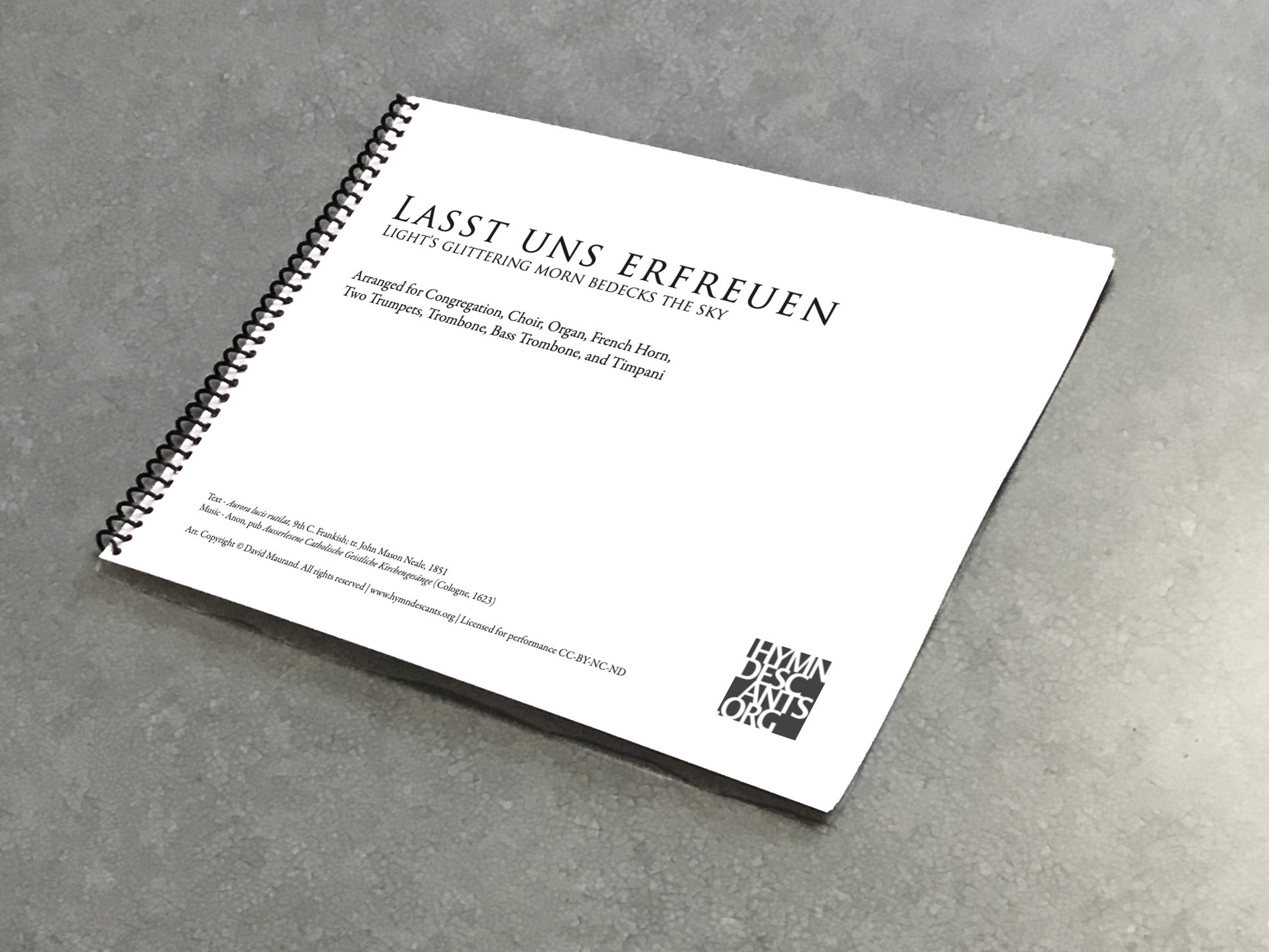
The eight-page signature version of the choir part is laid out ready to print in duplex mode short edge priority on 11x17 Ledger paper. This is a common feature of most office-grade printer copiers, but Staples can also do this for you as well.
Scans of Aurora lucis rutilat (Light's glittering morn) from 9th C Frankish Murbacher Hymnen - at the majuscule "A". The scribe is named as Reginbertus Augiensis c. 846 from the Benedectine abbey at Reichenau. The bishop of Reichenau, near Liechtenstein, was made abbot of Murbach Abbey in the Alsace, which is where this hymnal, the only known copy, was kept. It is Latin with interlinear glosses in Old High German. Bodleian Library, Oxford MS. Junius 25 folio 128v. and 129r.
